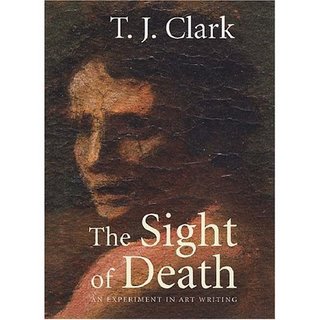
Just finished reading T.J. Clark's new experimental book on art writing titled "The Sight of Death" in which he studies two Poussin landscape paintings over an elongated period of time and notes exquisite details about each and enlightens the reader with euphomisms to take home and contemplate on during the train commute home.
Here are some highlights:
"We are living, I reckon, through a terrible moment in the politics of imaging, envisioning, visualizing; and the more a regime of visual flow, displacement, disembodiment, endless available revisability of the image, endless ostensible transparency and multi-dimensionality and sewing together of everything in nets and webs - the more this pseudo-utopia presents itself as the very form of self-knowledge, self-production, self-control - the more necessary it becomes to recapture what imaging can be..."
Clark reiterates the ultimate self-consciousness of art production, of visualization as victim to de-personifying experiences, stripping the private of its intimacy and over-democratizing and making available the single object. This of course due to such magical creations as the internet that allows me to take my self-knowledge into a form of self-production and recapture my experiences through mediums such as blog-writing!
"My art history has always been reactive. its enemies have been the various ways in which visual imagining of the world has been robbed of its true humanity, and conceived of as something less than human, non-human, brilliantly (or dully) mechanical"
Correct me if I'm interpreting him wrong but, I love and cherish T.J. Clark for his anti-formalism, his effort of "making the painting fully part of a world of transactions, interest, disputes, beliefs, "politics"...the sign of art's coming down from its ivory tower". That's exactly what this blog is about isn't it? It's about taking what you see and interpreting it accordingly to the society in which it originates. Its what I sense the art world consists of: the readability of art, the inclusive interpretation, the personalizing and availability of interpretation.
"When I am in front of a picture the thing I most want is to enter the picture's world: it is the possibility of doing so that makes pictures worth look at for me"
What a humbling experience it is to read art by entering it. Art writing and criticism would be so interesting and surreal if it was all about one person's subjective experience upton "entering" a work of art. I love it.
"[The Snake] is the most ambivalent of all things, and its form transfixes and repels. It is the bare fact of causation given a body, or the best figure we are ever likely to have of why things change at all and therefore have a history - why death entered the world, why darkness succeeds light"
This is my favorite section of the book where Clark writes about the snake as not only being phallic but also representative of the vagina as formless and encapturing, "...a body without established hierarchy among its constitutents". I now think how perfect to get a tattoo on my body of a snake in its basket, mysterious and ready to pounce, narcissitic and erotic for its self-touching and manipulating slithery-ness.
So here is my first real blog post. What a nerve wrecking but refreshing experience.

2 comments:
Amiable post and this fill someone in on helped me alot in my college assignement. Say thank you you for your information.
Understandably your article helped me terribly much in my college assignment. Hats afar to you send, will look progressive in behalf of more related articles soon as its sole of my pick subject-matter to read.
Post a Comment